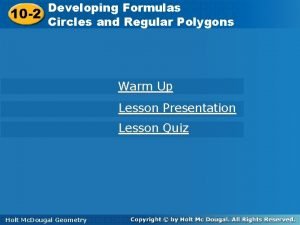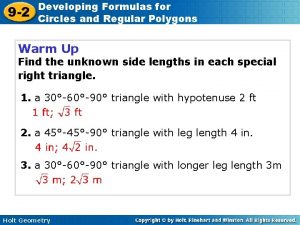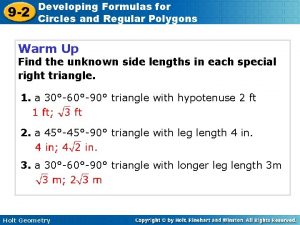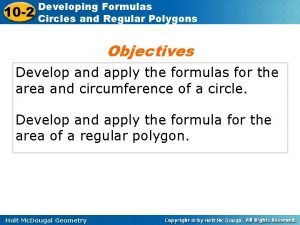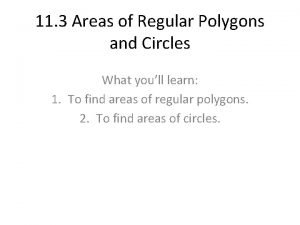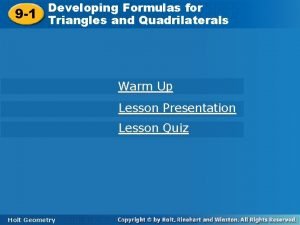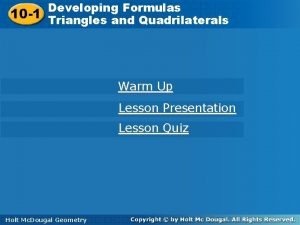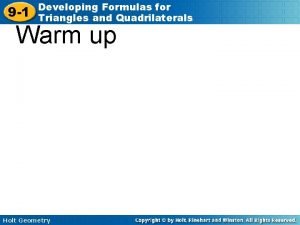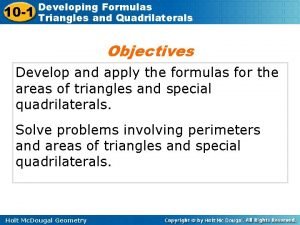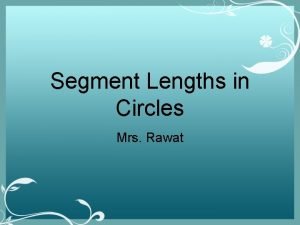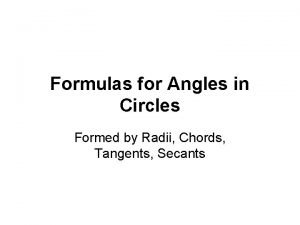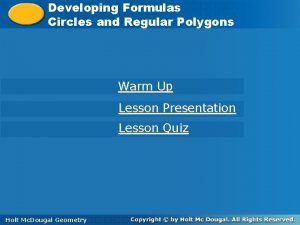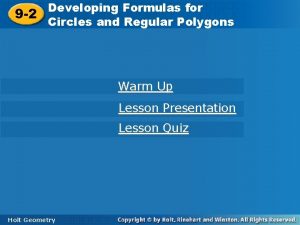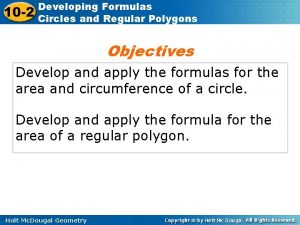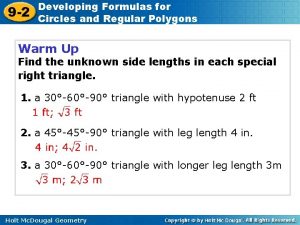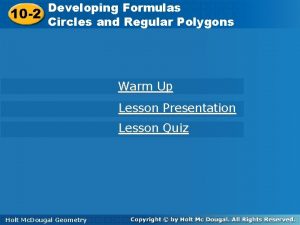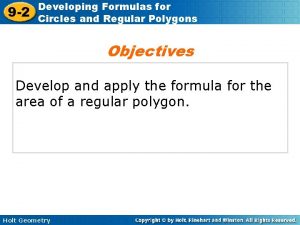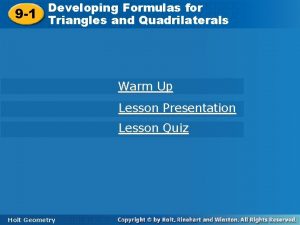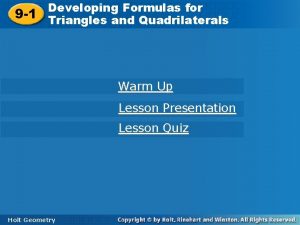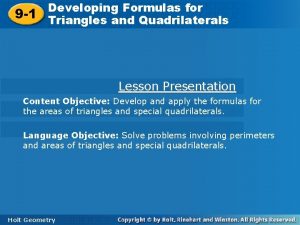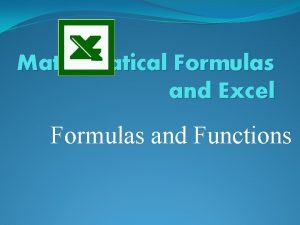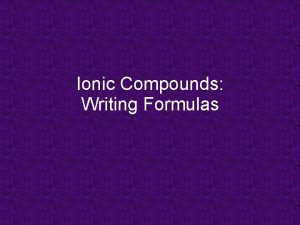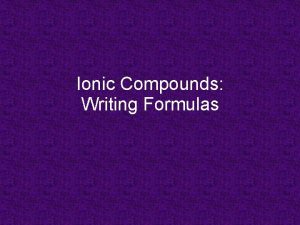9 2 Developing Formulas for Circles and Regular






















- Slides: 22

9 -2 Developing Formulas for Circles and Regular Polygons Objectives Develop and apply the formulas for the area and circumference of a circle. Develop and apply the formula for the area of a regular polygon. Holt Geometry

9 -2 Developing Formulas for Circles and Regular Polygons A circle is the locus of points in a plane that are a fixed distance from a point called the center of the circle. A circle is named by the symbol and its center. A has radius r = AB and diameter d = CD. The irrational number is defined as the ratio of the circumference C to the diameter d, or Solving for C gives the formula C = d. Also d = 2 r, so C = 2 r. Holt Geometry

9 -2 Developing Formulas for Circles and Regular Polygons Holt Geometry

9 -2 Developing Formulas for Circles and Regular Polygons Example 1 A: Finding Measurements of Circles Find the area of K in terms of . Holt Geometry A = r 2 Area of a circle. A = (3)2 Divide the diameter by 2 to find the radius, 3. A = 9 in 2 Simplify.

9 -2 Developing Formulas for Circles and Regular Polygons Example 1 B: Finding Measurements of Circles Find the radius of J if the circumference is (64 x) m. C = 2 r (64 x) = 2 r r = (32 x) m Holt Geometry Circumference of a circle Substitute (65 x + 14) for C. Divide both sides by 2.

9 -2 Developing Formulas for Circles and Regular Polygons Example 1 C: Finding Measurements of Circles Find the circumference of M if the area is 25 x 2 ft 2 Step 1 Use the given area to solve for r. A = r 2 Holt Geometry Area of a circle 25 x 2 = r 2 Substitute 25 x 2 for A. 25 x 2 = r 2 Divide both sides by . 5 x = r Take the square root of both sides.

9 -2 Developing Formulas for Circles and Regular Polygons Example 1 C Continued Step 2 Use the value of r to find the circumference. C = 2 r Holt Geometry C = 2 (5 x) Substitute 5 x for r. C = 10 x ft Simplify.

9 -2 Developing Formulas for Circles and Regular Polygons Check It Out! Example 1 Find the area of A in terms of in which C = (4 x – 6) m. A = r 2 A = (2 x – Area of a circle. 3)2 m Divide the diameter by 2 to find the radius, 2 x – 3. A = (4 x 2 – 12 x + 9) m 2 Simplify. Holt Geometry

9 -2 Developing Formulas for Circles and Regular Polygons Example 2: Cooking Application A pizza-making kit contains three circular baking stones with diameters 24 cm, 36 cm, and 48 cm. Find the area of each stone. Round to the nearest tenth. 24 cm diameter A = (12)2 ≈ 452. 4 cm 2 Holt Geometry 36 cm diameter A = (18)2 ≈ 1017. 9 cm 2 48 cm diameter A = (24)2 ≈ 1809. 6 cm 2

9 -2 Developing Formulas for Circles and Regular Polygons Check It Out! Example 2 A drum kit contains three drums with diameters of 10 in. , 12 in. , and 14 in. Find the circumference of each drum. 10 in. diameter 12 in. diameter 14 in. diameter C = d C = (10) C = (12) C = (14) C = 31. 4 in. C = 37. 7 in. C = 44. 0 in. Holt Geometry

9 -2 Developing Formulas for Circles and Regular Polygons Holt Geometry

9 -2 Developing Formulas for Circles and Regular Polygons The center of a regular polygon is equidistant from the vertices. The apothem is the distance from the center to a side. A central angle of a regular polygon has its vertex at the center, and its sides pass through consecutive vertices. Each central angle measure of a regular n-gon is Holt Geometry

9 -2 Developing Formulas for Circles and Regular Polygons Holt Geometry

9 -2 Developing Formulas for Circles and Regular Polygons Example 3 A: Finding the Area of a Regular Polygon Find the area of regular heptagon with side length 2 ft to the nearest tenth. Step 1 Draw the heptagon. Draw an isosceles triangle with its vertex at the center of the heptagon. The central angle is . Draw a segment that bisects the central angle and the side of the polygon to form a right triangle. Holt Geometry

9 -2 Developing Formulas for Circles and Regular Polygons Example 3 A Continued Step 2 Use the tangent ratio to find the apothem. The tangent of an angle is opp. leg. adj. leg Solve for a. Holt Geometry

9 -2 Developing Formulas for Circles and Regular Polygons Example 3 A Continued Step 3 Use the apothem and the given side length to find the area. Area of a regular polygon The perimeter is 2(7) = 14 ft. A 14. 5 ft 2 Holt Geometry Simplify. Round to the nearest tenth.

9 -2 Developing Formulas for Circles and Regular Polygons Example 3 B: Finding the Area of a Regular Polygon Find the area of a regular dodecagon with side length 5 cm to the nearest tenth. Step 1 Draw the dodecagon. Draw an isosceles triangle with its vertex at the center of the dodecagon. The central angle is . Draw a segment that bisects the central angle and the side of the polygon to form a right triangle. Holt Geometry

9 -2 Developing Formulas for Circles and Regular Polygons Example 3 B Continued Step 2 Use the tangent ratio to find the apothem. The tangent of an angle is Solve for a. Holt Geometry opp. leg. adj. leg

9 -2 Developing Formulas for Circles and Regular Polygons Example 3 B Continued Step 3 Use the apothem and the given side length to find the area. Area of a regular polygon The perimeter is 5(12) = 60 ft. A 279. 9 cm 2 Holt Geometry Simplify. Round to the nearest tenth.

9 -2 Developing Formulas for Circles and Regular Polygons Check It Out! Example 3 Find the area of a regular octagon with a side length of 4 cm. Step 1 Draw the octagon. Draw an isosceles triangle with its vertex at the center of the octagon. The central angle is . Draw a segment that bisects the central angle and the side of the polygon to form a right triangle. Holt Geometry

9 -2 Developing Formulas for Circles and Regular Polygons Check It Out! Example 3 Continued Step 2 Use the tangent ratio to find the apothem The tangent of an angle is opp. leg. adj. leg Solve for a. Holt Geometry

9 -2 Developing Formulas for Circles and Regular Polygons Check It Out! Example 3 Continued Step 3 Use the apothem and the given side length to find the area. Area of a regular polygon The perimeter is 4(8) = 32 cm. A ≈ 77. 3 cm 2 Holt Geometry Simplify. Round to the nearest tenth.
 10-2 developing formulas for circles and regular polygons
10-2 developing formulas for circles and regular polygons Developing formulas for circles and regular polygons
Developing formulas for circles and regular polygons 9-2 developing formulas for circles and regular polygons
9-2 developing formulas for circles and regular polygons 10-2 developing formulas for circles and regular polygons
10-2 developing formulas for circles and regular polygons Developing formulas for circles and regular polygons
Developing formulas for circles and regular polygons Area of polygons and circles
Area of polygons and circles 9-1 developing formulas for triangles and quadrilaterals
9-1 developing formulas for triangles and quadrilaterals Developing formulas for triangles and quadrilaterals
Developing formulas for triangles and quadrilaterals Developing formulas for triangles and quadrilaterals
Developing formulas for triangles and quadrilaterals Developing formulas for triangles and quadrilaterals 10-1
Developing formulas for triangles and quadrilaterals 10-1 Segment lengths in circles formulas
Segment lengths in circles formulas Secant-tangent theorem
Secant-tangent theorem Angle measurements and segment lengths
Angle measurements and segment lengths Which grammar generates regular language
Which grammar generates regular language Fspos
Fspos Typiska novell drag
Typiska novell drag Tack för att ni lyssnade bild
Tack för att ni lyssnade bild Ekologiskt fotavtryck
Ekologiskt fotavtryck Shingelfrisyren
Shingelfrisyren En lathund för arbete med kontinuitetshantering
En lathund för arbete med kontinuitetshantering Adressändring ideell förening
Adressändring ideell förening Tidböcker
Tidböcker Sura för anatom
Sura för anatom
